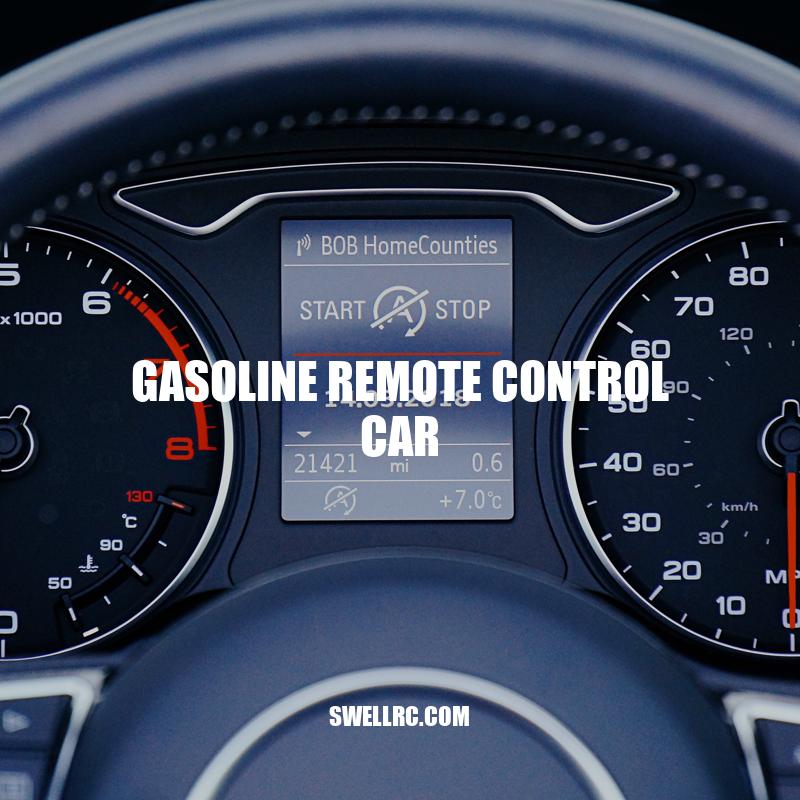Gasoline RC Cars: The Authentic Remote Control Experience
Remote control cars have long been a favorite pastime for hobbyists, and with good reason. Throughout the years, the technology used to create these cars has evolved, with newer options offering increased power, speed, and efficiency. One type of remote control car that has remained a popular choice for enthusiasts of all ages is the gasoline remote control car. Unlike electric remote control cars, these vehicles are powered by a gasoline engine, offering a more authentic and realistic driving experience. Whether you’re a car enthusiast, looking for a fun hobby, or simply want to try something new, a gasoline remote control car may be just what you need. In this article, we’ll delve into the world of gasoline remote control cars, exploring their history, benefits, types, and more.
Benefits of Gasoline Remote Control Cars
Gasoline remote control cars offer a variety of benefits to users, including:
- An authentic driving experience with the use of real gas-powered engines
- Longer run times compared to electric remote control cars before needing to refuel
- Increased power and speed, allowing for more challenging terrain and obstacles
- The ability to modify and upgrade the engine and other components for a customized driving experience
- A unique sound and smell, making for a more immersive driving experience
- Options for both on-road and off-road driving, depending on the type of car
For those who prioritize a more genuine driving experience, gasoline remote control cars are the perfect option. These cars offer the excitement of a real engine, with the convenience and flexibility of a remote control car. If you’re interested in purchasing a gasoline remote control car for yourself, there are several resources available. Popular websites such as Amazon and HobbyKing offer a variety of options to suit different needs and budgets. Additionally, local hobby shops may have gasoline remote control cars available for purchase, along with replacement parts and accessories.
Maintenance and Care for Gasoline Remote Control Cars
Proper maintenance and care for your gasoline remote control car is crucial to ensure it runs smoothly and lasts as long as possible. Here are some tips for maintaining and caring for your car:
- Always run the engine at idle speed for a few minutes before driving to warm it up
- Check the fuel tank before each use, and refill as needed
- Clean the air filter regularly with compressed air to prevent clogging
- Tighten screws and bolts periodically to prevent components from loosening during driving
- Replace parts such as spark plugs and air filters when they become worn or damaged
- Store your car in a cool, dry place to prevent rust and corrosion
In addition to regular maintenance, troubleshooting issues as they arise is important for prolonging the life of your car. Common issues with gasoline remote control cars include fuel leaks, stalling, and engine tuning problems. Consulting the car’s user manual or online forums and communities for advice can help you solve these issues quickly and efficiently.
When purchasing replacement parts or upgrading your gasoline remote control car, it’s important to source parts from reputable websites or stores. Incompatibility or poor quality parts can cause more harm than good. Many manufacturers also offer parts and accessories specific to their car models, such as different wheel sizes and body designs. The table below outlines some popular gasoline remote control car brands and their product offerings.
| Brand | Product Offerings |
|---|---|
| Traxxas | Nitro Sport – T-Maxx – Jato – Revo – Slayer – Nitro 4-Tec – Nitro Rustler |
| HPI Racing | Nitro RS4 3 – Savage – Baja 5B – WR8 – Bullet |
| Team Associated | RC8.2e – RC8.2 – RC8-T CE – MGT 4.6 |
How do you maintain a nitro RC car?
To maintain a nitro RC car, follow these steps:
- Regularly clean the car, especially after each use, to prevent dirt and debris from building up and causing damage.
- Check for wear and tear on the tires, shocks, and suspension system, and replace any damaged parts.
- Check the fuel level and clean or replace the air filter as needed.
- Inspect the engine regularly and replace any worn or damaged parts, such as glow plugs or pistons.
- Store the car properly, in a cool, dry place, away from sunlight and moisture.
For more detailed information and tutorials on nitro RC car maintenance, check out websites like RC Universe or RC Car Action. You can also find products like nitro RC car cleaning kits and replacement parts on websites like Amazon or Tower Hobbies.
Types of Gasoline Remote Control Cars
Gasoline remote control cars are available in a variety of sizes and capabilities to suit different skill levels and interests. Here are some types of gasoline remote control cars on the market:
- 1/10 Scale On-Road Cars: Designed for racing on smooth surfaces, such as paved roads and tracks. They are built for speed and maneuverability with low profile tires and aerodynamic bodies.
- 1/10 Scale Off-Road Cars: Built for rugged terrain, such as dirt and gravel surfaces. They have larger tires with more aggressive tread patterns and higher suspension for better ground clearance.
- 1/8 Scale Buggies: A larger and more powerful type of off-road car, with even higher ground clearance and larger tires.
- 1/5 Scale Gasoline Remote Control Cars: The largest type of gasoline remote control car available, with sizes similar to full-size cars. These cars are typically used for racing and are not as common due to their higher cost and more specialized equipment requirements.
When considering purchasing a gasoline remote control car, it’s important to research different types and brands to find the best fit for your interests and skill level. Popular brands include Traxxas, HPI Racing, and Team Associated, as well as smaller boutique brands specializing in specific types of cars. Online forums and communities can be a great resource for finding recommendations and advice.
In addition to gasoline remote control cars, there are also alternative fuel options such as nitro (a methanol-based fuel) and electric-powered remote control cars. Nitro cars offer similar engine sounds and authenticity to gasoline cars, but require more maintenance and can be less fuel efficient. Electric cars offer quieter operation and less maintenance, but have shorter run times and less power than gasoline and nitro cars.
Ultimately, the type of car you choose will depend on your personal preferences and budget. With proper maintenance and care, a gasoline remote control car can provide years of enjoyment and entertainment for hobbyists of all ages.
How many types of remote control cars are there?
There are several types of remote control cars available in the market. Some of the popular types are:
- Off-road cars for rough terrain and bumpy rides
- On-road cars for smooth surfaces and high-speed racing
- Drift cars designed for sliding and drifting around corners
- Crawler cars for rocky and uneven terrains
- Monster trucks for high jumps and stunts
Many websites offer a range of remote control cars for all age groups and skill levels. Some popular websites are Amazon, HobbyTron, and HorizonHobby.
RTR vs. Kit-Built Gasoline Remote Control Cars
When it comes to purchasing a gasoline remote control car, there are two main options available: ready-to-run (RTR) and kit-built cars. RTR cars come fully assembled and ready to use out of the box, while kit-built cars require more time and effort to assemble and may require additional equipment or tools. Both options have their pros and cons and are suited to different skill levels and interests.
One major advantage of RTR cars is that they are easy to use and require little to no experience with remote control cars. They come with clear instructions and all the necessary components, making them an excellent choice for beginners or younger hobbyists. RTR cars also tend to be less expensive than kit-built cars, making them an affordable option for those on a budget.
Kit-built cars, on the other hand, offer more customization and personalization options. They allow you to choose your own components and build the car according to your preferences and specifications. This can be a rewarding experience for experienced hobbyists who are passionate about remote control cars and want to create something unique and specialized.
However, kit-built cars do have some downsides. They require more time and effort to assemble and may be more challenging for beginners. They also tend to be more expensive, as you will need to purchase each component separately.
In conclusion, whether you choose an RTR or kit-built gasoline remote control car depends on your skill level, budget, and personal preferences. RTR cars are a great option for beginners or those on a budget, while kit-built cars offer more customization and personalization options for experienced hobbyists. Whatever option you choose, be sure to properly maintain and care for your car to extend its lifespan and ensure many hours of enjoyment.



